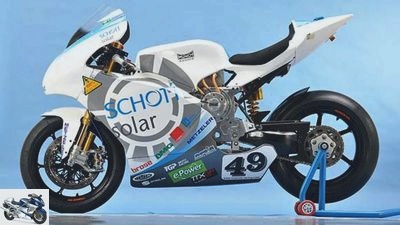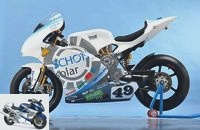Menus

Sdun
Technology and driving report from the Munch TTE-2
Electric racing motorcycle from Munch
The Munch electric racer not only carries electricity, it is also unchallenged in the international championships. The German Munch Racing Team spoke to MOTORRAD about technology, tactics and titles at the exclusive appointment.
People, you have to relearn ”, says Thomas Schuricht mischievously. “In the future, it will no longer be about two or four cylinders, but rather synchronous or asynchronous. And about brushless or brushless motors. ”Schuricht knows his way around: With a brushless synchronous motor, the Munch TTE-2 electric racer he developed drove to the top of the podium in six of seven world championship races last year. For the second time in a row, pilot Matthias Himmelmann brought the world title to Germany – but largely unnoticed by the public.
But e-mobility is trendy, which promises a boost for the racing series. “Success in sport is important, on the racetrack we can best develop the technology and at the same time show people that electric motorcycles have nothing to do with boring eco-slippers,” says Thomas Petsch. The Wurzburg businessman holds the rights to the name Munch. Around 15 years ago, together with the legendary developer Friedel Munch, he put the Mammut 2000 on its wheels, with its two-liter turbo engine, at that time the most powerful small-series motorcycle in the world, but soon gave up for cost reasons. Then Petsch aligned the Munch brand in the direction of electromobility and brought the qualified electrical engineer Thomas Schuricht on board as a partner.
“The name Munch stands for high-quality vehicles that are built in small numbers,” says Schuricht. “So it’s just the right thing for our electric racing motorcycle.” It was important for the two partners from the start to use the best technology. The TTE-2 racing machine is equipped with the finest components, from the expensive Ohlins chassis and a superbike swingarm to the Brembo racing brake system; The team designed the self-supporting carbon rear end and the chrome-molybdenum-steel tubular space frame itself. For the heart, the electric drive, Petsch and Schuricht decided on a brushless synchronous DC motor. “It is more heat-sensitive and more difficult to control than the brush motors of the competition, but it is also stronger, more innovative and much less susceptible to wear,” explains chief developer Schuricht.
B.Both types of drive are based on the same basic concept. These are so-called permanently excited DC motors. But while with the brush motor the necessary polarity reversal of the current that is drawn from the drive batteries takes place via the name-giving brushes, with the brushless motor it is done electrically and therefore much more complex. The water-cooled synchronous motor achieves over 90 percent efficiency; conventional gasoline engines reach a maximum of 30 percent. The Munch drive develops 122 hp for a short time and thus achieves a top speed of 240 km / h. What is particularly impressive, however, is the torque of 85 Newton meters, which is applied linearly and thus enables an unusually powerful acceleration.
Buy complete article

Technology and driving report from the Munch TTE-2
Electric racing motorcycle from Munch
Driving report Munch TTE-2
Jahn
A real experience: Munch’s E-Racer starts with a powerful start.
Is Elektro-Munch really making progress and is it also having fun, as its developers claim? MOTORRAD editor Andreas Bildl has tried out what the fast Stromer feels like.
Silence hangs over the -Alcarràs racetrack in Spain. Only in the distance can a hoarse hissing sound be heard from the pit lane. It swells, gets louder, accompanied by high-frequency buzzing and whistling. Then suddenly a white motorcycle shoots over the hilltop, plunges almost silently into the following left-hand bend and has disappeared like a ghost.
An encounter with this racing motorcycle is anything but ordinary. Even if the Munch TTE-2 initially feels like a completely normal motorcycle. A little high, but very pleasant, it embeds its driver. The chassis – an Ohlins fork at the front, a TTX strut from the same manufacturer at the rear – pretty tightly tuned, plus a thin, feel-good foam rubber seat pad. Nothing new so far. Nearly.
“As long as the charge indicator doesn’t drop below 270 volts when you accelerate and the battery temperature doesn’t rise above 40 degrees, you can stay outside. Have fun ”, Munch’s chief developer Thomas Schuricht had given before the start. The new lithium polymer (LiPo) batteries must first be run in. This means completing a few charging cycles without discharging too deeply. Once the batteries are run in, around 240 amps at 350 volts wait under the pilot to tickle a total of 75 kilowatts or around 102 hp from the three-phase motor. In qualifying, 20 amps more are released, which makes 122 hp.
In the saddle of the Munch, even rolling out of the pit lane looks like from another world. The only sounds are the whirring of the drive chain and a very low hum of the motor. However, all senses should be in the watchful position in order to keep your feet and preferably your left hand still. Because both shift and brake pedals are missing. There is no transmission and the left hand lever activates the foot brake. The reflex-like grip when braking to the nonexistent clutch could quickly lead to a veritable cross-stay. The first laps on the e-racer are like a first driving lesson – just not a wrong move. And finally the big question arises: Can such a motorcycle turn in the normal way? Can it drive at an angle? Can speed it up?
Oh yes it can. And how. At first, however, there is great respect for the curves. When the throttle is closed, the engine does not have any braking torque. The load shoots into the curve at an undiminished high speed because the race is driven without recuperation, i.e. without energy recovery, in order to protect the batteries thermally. From the depths of long-term memory, memories of driving two-stroke engines come up, which can help. However: Without engine noise and gear changes, how should you correctly estimate the speed before the curve? Damn tricky. But after two or three laps you have adjusted, things start to slip.
The Munch does not turn as easy as a 600, the nimble jiggles through chicanes and are easier to squeeze into a tight line at the exit of a curve. Since the Munch is more like a full 1000 and requires a little pull on the handlebars for deeper slopes. But then it arrows neatly on the targeted line through the curve and is only slightly disturbed by bumps.
The most impressive experience awaits from the middle of the curve. Pull on the “gas” – and the Munch pushes it forward very gently, as if pulled by a huge rubber band. If internal combustion engines would accelerate so smoothly. The Munch does not accelerate with the aggressive bite of a high-revving four-cylinder, but much more linearly and with more pressure from below. The full throttle position does not fire maximum current into the motor; rather, the motor control determines how much current should flow and what torque is available from the speed and throttle position. This gentle and powerful acceleration and the tremendous grip on the rear wheel encourage you to tighten the tap earlier and more forcefully. A 600 has to stretch to keep up.
Now again full shower over the home straight, maximum speed 12700 / min, almost 200 km / h according to the GPS measurement at the braking point. A fully squeezed series 600 is around 25 km / h and around two to three seconds faster per lap. But ultimately, Munch shows that the electric racers have meanwhile blossomed into serious sports machines in terms of driving dynamics, which have long outgrown the craft booth milieu. Nowadays, the e-racers have long been racing in their own world championships – still in silence, but no longer in secret.
Related articles
-
Trinity Neon electric motorcycle
New items 2019 Top topic Trinity Electric Vehicles 6th photos Trinity Electric Vehicles 1/6 Trinity launches its first own electric motorcycle on the…
-
Verge TS – electric motorcycle from Finland
New items 2019 Top topic Verge Motorcycles. 18th photos RMK 1/18 Originally the Verge was supposed to be called TS RMK E2. RMK 2/18 After the first…
-
NXT Rage electric motorcycle Netherlands
Innovations 2019 Top topic NXT Motors 5 images NXT Motors 1/5 NXT Motors from the Netherlands has presented its first electric motorcycle, the Rage. NXT …
-
Velocifero Beach Mad: hip electric motorcycle with balloon tires
Velocifero. 8th photos Velocifero. 1/8 This new bike is called the Velocifero Beach Mad and was first introduced at the Bangkok International Motor Show….
-
CF Moto 300GT-E: Electric police motorcycle
CF Moto 8th photos CF Moto 1/8 The Chinese motorcycle manufacturer CF Moto has now presented its first electric motorcycle. CF Moto 2/8 The CF Moto…
-
Kalashnikov SM-1 electric motorcycle
Kalashnikov Kalashnikov SM-1 Electric motorcycle from Russia The Russian arms company Kalashnikov has now presented the electric motorcycle SM-1 at a…
-
Sur-Ron Firefly Electric Motorcycle 2018
New items 2019 Top topic Dervish Sur-Ron Firefly (2018) at INTERMOT Electric motorcycle like a mountain bike The Chinese manufacturer Sur-Ron has…
-
Honda electric motorcycle: patent shows e-bike at 125cc level
Honda 4th photos Honda 1/4 A new patent for a small Honda electric motorcycle has appeared on the Internet. Honda 2/4 The electric motor looks extremely…
-
Cake Kalk OR in the test: electric motorcycle from Sweden
Beyl 25th photos Ridecake 1/25 The Swedish manufacturer Cake launched a small enduro, the Kalk OR, in 2018. Ridecake 2/25 The company philosophy of Cake…
-
Kawasaki EV Endeavor electric motorcycle
Motorcycle fair in Milan EICMA 2019 Presented by Kawasaki 25th photos Jorg Kunstle 1/25 At EICMA 2019, Kawasaki is showing a rolling chassis called the…